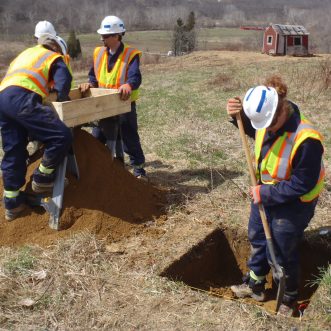On January 30, the Pennsylvania Department of Environmental Protection (PADEP) Bureau of Waterways Engineering and Wetlands (BWEW) proposed significant amendments to Pennsylvania Chapter 105 Waters Obstruction/Encroachment Regulations for review of dam, stream, and wetland permits, as well as compensatory mitigation plans. The purpose of the amendments is to clarify and codify existing requirements and delete or revise obsolete requirements and references. In this post, we cover the significant changes to § 105.12 waivers, the undefined terms used in the proposed amendments, and the changes to Joint Permit Application requirements.

Significant Changes to § 105.12 Waivers
- Submerged Lands of the Commonwealth (state-owned stream beds) are excluded from waiver claims.
- Waiver 2 (for impacts to streams with drainage areas fewer than 100 acres) will be curtailed by requiring that activities not impede flow or aquatic life passage and not exceed 100 feet of stream enclosure (i.e. culverting). This change appears to restrict Waiver 2, as it may not be applicable for fills of small streams, resulting in a greater burden of proof to demonstrate waiver applicability.
- Waiver 3 (for overhead utility lines), which is also used for placement of poles in waters, will be limited to single poles without foundations, thus restricting use for larger steel poles or similar structures.
- Waiver 11 (for removal of existing structures) will be expanded to cover the abandonment of structures.
- New waivers are proposed for:
- Streambank fencing conservation practice associated with crop production (i.e. grazing);
- Low-impact and non-motorized recreational trails (maximum of 75 feet long);
- Elevated boardwalks in wetlands for educational and interpretive trails (if the plan is approved by the PADEP);
- Emergency water withdrawal for crop production and fire protection;
- Temporary environmental testing and monitoring activities (including geotechnical boring); and
- Temporary mats and pads in wetlands used to prevent sedimentation/compaction.
Undefined Terms
The proposed amendments use many new terms that could be subject to inconsistent discretionary judgement by PADEP reviewers if not more clearly defined. Those terms include:
- Abandonment;
- Reasonably foreseeable future development;
- Project-wide cumulative wetland impact analysis;
- Impede flow;
- Geomorphic stability;
- Commensurate level of effort;
- Indirect impacts;
- Low Impact;
- Periodic; and
- Temporary emergency.

Changes to Joint Permit Application Requirements
The requirements for Joint Permit Applications are expanded and significantly revised. Specific changes are:
- The instructions now specify scale and content requirements for pre- and post-construction cross-sections of waters;
- Guidance is now provided on required content for a narrative discussion and analysis of water dependency in the project description;
- Criteria for alternatives analysis and mitigation plan sections are expanded. These changes imply a greater burden of proof to the applicant and will require some clarification from the PADEP;
- A cumulative impact analysis (CIA) section has been added, requiring the applicant to assess cumulative impacts to wetlands for the overall project. Due to similarity in requirements for the Comprehensive Environmental Assessments, clarification is needed to differentiate the CIA; and
- Wetland replacement criteria, outlined in 105.20a, is replaced in its entirety.
What’s Next?
While the intent and purpose of many changes can be readily understood, some will require more clarification from the PADEP. Please contact Jonathan Farrell (jfarrell@cecinc.com) or Ryan MacWilliams (rmacwilliams@cecinc.com) with your input on the proposed changes. If you’d rather express your concerns directly to the PADEP, the contact is Roger Adams, Director Bureau of Waterways Engineering and Wetlands, 717-772-5951, roadams@pa.gov.
The next step for the draft amendments is review and approval by the Environmental Quality Board at their next meeting on April 21, 2020, followed by a Public Notice in the Pennsylvania Bulletin for 60 days of public comment.
[Editor’s note: An earlier version of this post noted that the Environmental Quality Board’s next meeting is in mid-March. That meeting has been canceled; this post has been updated to reflect that the next meeting is on April 21.]

Post a Comment